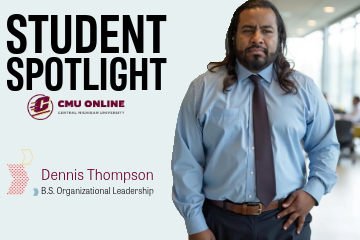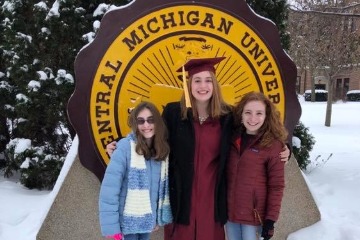STEM Center offers a learning lifeline
Partnership with Teachers of the Year creates a collection of remote teaching resources
Experts on Point is a University Communications series focusing on CMU professionals who have special insights into interesting, important and timely topics.
STEM is short for science, technology, engineering and math. This year, the "T" may stand out more than usual: Technology is central to 2020's ever-present online meetings and virtual events.

As director of Central Michigan University's Center for Excellence in STEM Education, Julie Cunningham knows what K-12 teachers and administrators are up against as the school year begins.
"Many of them are facing the challenge of offering instruction in multiple formats at once or offering instruction in a format that does not easily fit the content," she said. "For example, it is difficult to offer an online science lab experiment."
Cunningham began talking with the Michigan Teacher of the Year Network, or MTOY, about offering teachers free digital tools, lessons and more. The resulting partnership created the Collection of STEM Teaching Resources. We asked Cunningham about that project and other STEM Center efforts.
Q: What is the Center for Excellence in STEM Education?
A: The physical site in Room 134 of the Education and Human Services building is a "maker space" for STEM learning with regional students, families and teachers, in addition to teacher candidates in the STEM Education Scholar Program. Additionally, the center serves a large number of patrons offsite in local schools, library branches and children's museums. Finally, the center has a large online presence, with resources listed on the website. About 45 undergraduate teacher candidate students, freshmen through seniors, are STEM Education Scholars.
![cut-LEGO-Challenges[2]](/images/default-source/presidents-division/university-communications/news/2021/2021-2/cut-lego-challenges-2-7e0fd143-9829-48ff-9873-6e50b10f030d.jpg?Status=Master&sfvrsn=80d50acf_3)
Q: What are K-12 teachers and schools facing this fall?
A: Schools face the challenge of offering quality instruction to students while keeping students, teachers and staff safe. They also face a challenge of not knowing what the school year will bring, whether they will remain offering instruction in whatever format they began or whether they will have to pivot to a new format. Those who were asked to pivot from face-to-face to virtual instruction may face an added barrier of students not having reliable internet or technology and instructors largely being responsible for teaching themselves how to use virtual tools in order to use them for instruction with kids.
Q: What are a few examples of the resources you've collected?
A: A folder for each grade level band suggests social media hashtags, blogs and websites to follow, short articles in STEM education, video tutorials, books, on-demand professional learning for the teacher, apps and web tools, all in addition to lessons and activities. MTOY was very thorough, and we think teachers will find the resources useful for classroom instruction.
A couple of our favorite podcasts are STEM Everyday and STEM Read, because they highlight teachers and experts in the field while providing inspiration and practical tips.
Q: How can educators access these resources?
A: Teachers can access the work through our website. Additionally, teachers looking for something specific can e-mail Ashley O'Neil, coordinator of STEM education community engagement, at biede1aj@cmich.edu.
Q: How did the STEM Center come to partner with the Teacher of the Year Network?
A: The center had an opportunity to work with a Teacher of the Year honoree on a professional learning project for teachers with the Belle Isle Conservancy in Detroit. We were able to support 20 teachers' attendance at the workshops and their continued work on the project they developed for their classrooms. It was through this relationship that the center connected with the broader Michigan Teacher of the Year Network and began the discussion about offering digital resources by grade levels to teachers through the center.
Do the Teachers of the Year involved in the project include CMU alumni?
A: Yes. David Bunn curated seventh-grade resources for the project. He's a 2001 CMU education graduate who teaches science and STEM at Houghton Lake High School.
Erin Carlson curated third, fourth and fifth-grade special education resources. She graduated from CMU in 2005 and teaches STEM and English at Sandusky Junior/Senior High.
They're both 2020-21 regional Teachers of the Year.
Q: Why is STEM important for all learners?
A: STEM requires an integration of several content areas, including artistic, written and oral communication skills. When students attend a program with the STEM Center, the focus is on providing them a problem to solve using STEM skills. It is important for all students to learn to solve problems for themselves and to understand that they are capable of understanding and influencing the world around them.
Q: What's next for STEM Center plans and programs?
A: We will continue to offer all programs virtually this fall. Some of our new programs are drop-in field trips for families teaching their children at home, weekly workshops by grade level that feature material kits for pickup, and virtual field trips for classrooms, including a new co-teaching option for teachers who wish to be more involved. Our STEM Education Scholars will be invited to participate in the virtual programming as well.
The center continues to support teachers who worked with us over the summer in a professional learning workshop as they transition to their classrooms this fall. We also will continue to offer family events, Facebook activity video invites and Invention Convention participation by classrooms in a virtual format.
About the expert
Julie Cunningham has a Bachelor of Science degree in zoology from the University of Wisconsin-Madison, teaching certification from UW-Oshkosh and a master's degree in curriculum and instruction from UW-Madison. She has worked in education for 25 years, the first 15 as a high school science instructor and the past 10 in higher education as an instructional coach and faculty member. She has spent the past five years developing the Center for Excellence in STEM Education.




